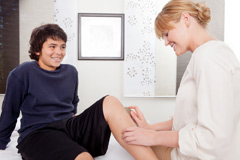Growing pains (Traction Apophysitis) can occur in children following a period of rapid growth and/ or increase in sporting activity. During periods of rapid skeletal growth (think teenagers suddenly almost growing overnight) the cartilage within long bones of the body is weaker and becomes more susceptible to injury.
Growing pains most commonly affect tendon attachments at these sites: the heel (Sever’s disease), below the knee cap (Osgood-Schlatter’s) and at the base of the knee cap (Sindig-Larsen-Johansson). Often these children participate in football as well as other running and jumping sports.
Onset is usually gradual with pain over the areas mentioned above. Unfortunately, often growing pains mean the child ends up resting from their sport. However, rest alone often does not solve the issue, with pain returning when the child attempts to return to activity. Bone often grows quicker than the muscle has time to stretch and adapt causing increased tension at the tendon attachment which can cause pain to develop. We cannot control this!
However, we can have some control over other contributing factors such as;
- Training load- how frequently/ intense training is, is it varied and balanced with good emphasis on technique and rest?
- Poor biomechanics
- Poor capacity of muscles to deal with rapid skeletal growth
Obtaining an early diagnosis and appropriate management plan should reduce the impact on a child’s participation in sport. An individualised rehabilitation program should be devised with the help of your physiotherapist to address the factors outlined above. A physio will also advise on which activities to temporarily limit and which to continue with and future training strategies.

Lisa
Blog post by Lisa
Senior Physiotherapist
MSc MACP MHCPC MCSP
Emma James Physio


 It is important to see an experienced and
It is important to see an experienced and 

 However, we can have some control over other contributing factors such as;
However, we can have some control over other contributing factors such as;
Recent Comments